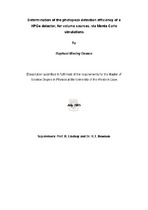| dc.description.abstract | The Environmental Radioactivity Laboratory (ERL) at iThemba LABS undertakes experimental work using a high purity germanium (HPGe) detector for laboratory measurements. In this study the Monte Carlo transport code, MCNPX, which is a general-purpose Monte Carlo N − Particle code that extends the capabilities of the MCNP code, developed at the Los Alamos National Laboratory in New Mexico, was used. The study considers how various parameters such as (1) coincidence summing, (2) volume, (3) atomic number (Z) and (4) density, affects the absolute photopeak efficiency of the ERL’s HPGe detector in a close geometry (Marinelli beaker) for soil, sand, KCl and liquid samples. The results from these simulations are presented here, together with an intercomparison exercise of two MC codes (MCNPX and a C++ program developed for this study) that determine the energy deposition of a point source in germanium spheres of radii 1 cm and 5 cm.
A sensitivity analysis on the effect of the detector dimensions (dead layer and core of detector crystal) on the photopeak detection efficiency in a liquid sample and the effect of moisture content on the photopeak detection efficiency in sand and soil samples, was also carried out. This study has shown evidence that the dead layer of the ERL HPGe detector may be larger than stated by the manufacturer, possibly due to warming up of the detector crystal. This would result in a decrease in the photopeak efficiency of up to 8 % if the dead layer of the crystal were doubled from its original size of 0.05 cm. This study shows the need for coincidence summing correction factors for the gamma lines (911.1 keV and 968.1 keV) in the 232Th series for determining accurate activity concentrations in environmental samples. For the liquid source the gamma lines, 121.8 keV, 244.7 keV, 444.1 keV and 1085.5 keV of the 152Eu series, together with the 1173.2 keV and 1332.5 keV gamma lines of the 60Co, are particularly prone to coincidence summing. In the investigation into the effects of density and volume on the photopeak efficiency for the KCl samples, it has been found that the simulated results are in good agreement with experimental data. For the range of sample densities that are dealt with by the ERL it has been found that the drop in photopeak efficiency is less than 5 %. This study shows that the uncertainty of the KCl sample activity measurement due to the effect of different filling volumes in a Marinelli beaker is estimated in the range of 0.6 % per mm and is not expected to vary appreciably with photon energy. In the case of the effect of filling height on the efficiency for the soil sample, it was found that there is a large discrepancy in the trends of the simulated and experimental curves. This discrepancy could be a result of the use of only one sand sample in this study and therefore the homogeneity of the sample has to be investigated. The effect of atomic number has been found to be negligible for the soil and sand compositions for energies above 400 keV, however if the composition of the heavy elements is not properly considered when simulating soil and sand samples, the effect of atomic number on the absolute photopeak efficiency in the low energy (< 400 keV) region can make a 14 % difference. | en_US |

